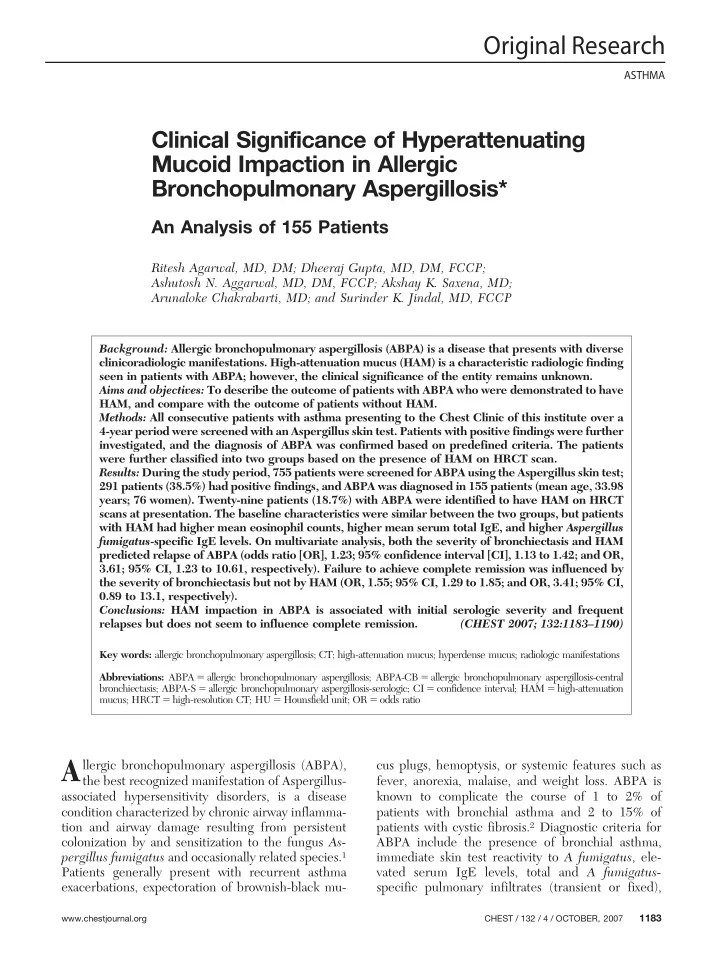

Original Research ASTHMA Clinical Significance of Hyperattenuating Mucoid Impaction in Allergic Bronchopulmonary Aspergillosis* An Analysis of 155 Patients Ritesh Agarwal, MD, DM; Dheeraj Gupta, MD, DM, FCCP; Ashutosh N. Aggarwal, MD, DM, FCCP; Akshay K. Saxena, MD; Arunaloke Chakrabarti, MD; and Surinder K. Jindal, MD, FCCP Background: Allergic bronchopulmonary aspergillosis (ABPA) is a disease that presents with diverse clinicoradiologic manifestations. High-attenuation mucus (HAM) is a characteristic radiologic finding seen in patients with ABPA; however, the clinical significance of the entity remains unknown. Aims and objectives: To describe the outcome of patients with ABPA who were demonstrated to have HAM, and compare with the outcome of patients without HAM. Methods: All consecutive patients with asthma presenting to the Chest Clinic of this institute over a 4-year period were screened with an Aspergillus skin test. Patients with positive findings were further investigated, and the diagnosis of ABPA was confirmed based on predefined criteria. The patients were further classified into two groups based on the presence of HAM on HRCT scan. Results: During the study period, 755 patients were screened for ABPA using the Aspergillus skin test; 291 patients (38.5%) had positive findings, and ABPA was diagnosed in 155 patients (mean age, 33.98 years; 76 women). Twenty-nine patients (18.7%) with ABPA were identified to have HAM on HRCT scans at presentation. The baseline characteristics were similar between the two groups, but patients with HAM had higher mean eosinophil counts, higher mean serum total IgE, and higher Aspergillus fumigatus -specific IgE levels. On multivariate analysis, both the severity of bronchiectasis and HAM predicted relapse of ABPA (odds ratio [OR], 1.23; 95% confidence interval [CI], 1.13 to 1.42; and OR, 3.61; 95% CI, 1.23 to 10.61, respectively). Failure to achieve complete remission was influenced by the severity of bronchiectasis but not by HAM (OR, 1.55; 95% CI, 1.29 to 1.85; and OR, 3.41; 95% CI, 0.89 to 13.1, respectively). Conclusions: HAM impaction in ABPA is associated with initial serologic severity and frequent relapses but does not seem to influence complete remission. (CHEST 2007; 132:1183–1190) Key words: allergic bronchopulmonary aspergillosis; CT; high-attenuation mucus; hyperdense mucus; radiologic manifestations Abbreviations: ABPA � allergic bronchopulmonary aspergillosis; ABPA-CB � allergic bronchopulmonary aspergillosis-central bronchiectasis; ABPA-S � allergic bronchopulmonary aspergillosis-serologic; CI � confidence interval; HAM � high-attenuation mucus; HRCT � high-resolution CT; HU � Hounsfield unit; OR � odds ratio A llergic bronchopulmonary aspergillosis (ABPA), cus plugs, hemoptysis, or systemic features such as the best recognized manifestation of Aspergillus- fever, anorexia, malaise, and weight loss. ABPA is associated hypersensitivity disorders, is a disease known to complicate the course of 1 to 2% of condition characterized by chronic airway inflamma- patients with bronchial asthma and 2 to 15% of patients with cystic fibrosis. 2 Diagnostic criteria for tion and airway damage resulting from persistent colonization by and sensitization to the fungus As- ABPA include the presence of bronchial asthma, pergillus fumigatus and occasionally related species. 1 immediate skin test reactivity to A fumigatus , ele- Patients generally present with recurrent asthma vated serum IgE levels, total and A fumigatus- exacerbations, expectoration of brownish-black mu- specific pulmonary infiltrates (transient or fixed), 1183 www.chestjournal.org CHEST / 132 / 4 / OCTOBER, 2007
Recommend
More recommend